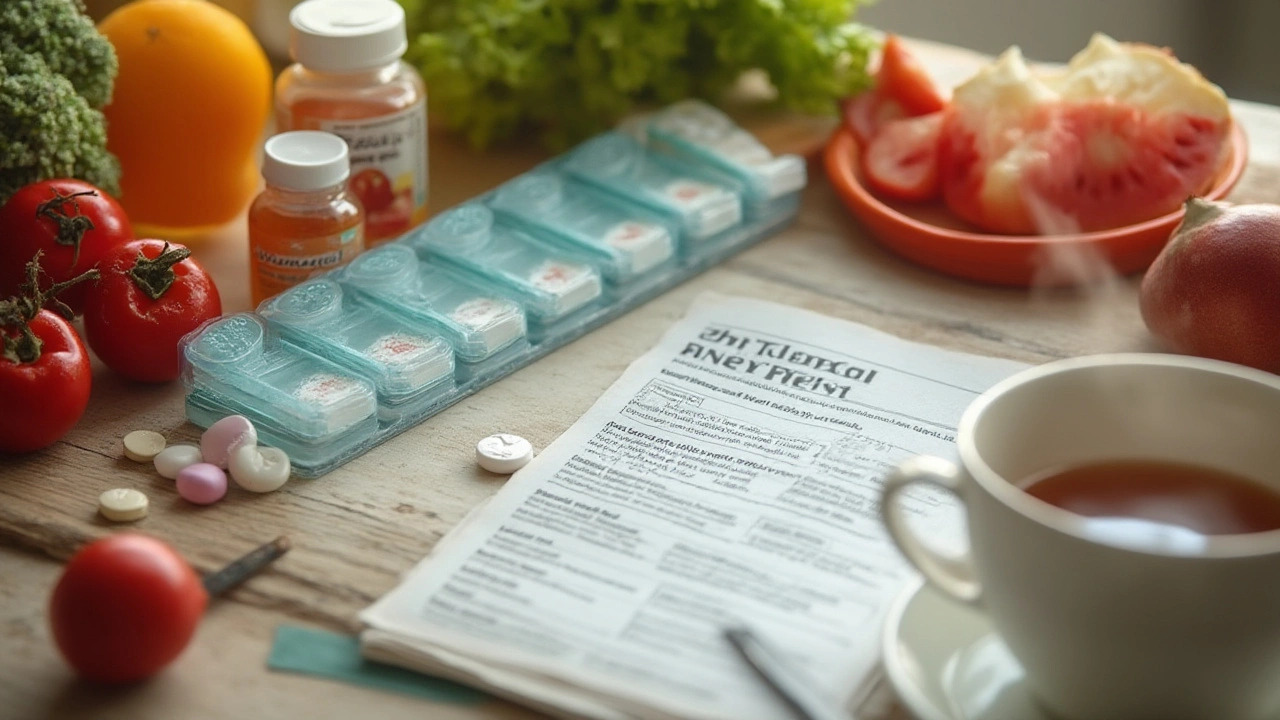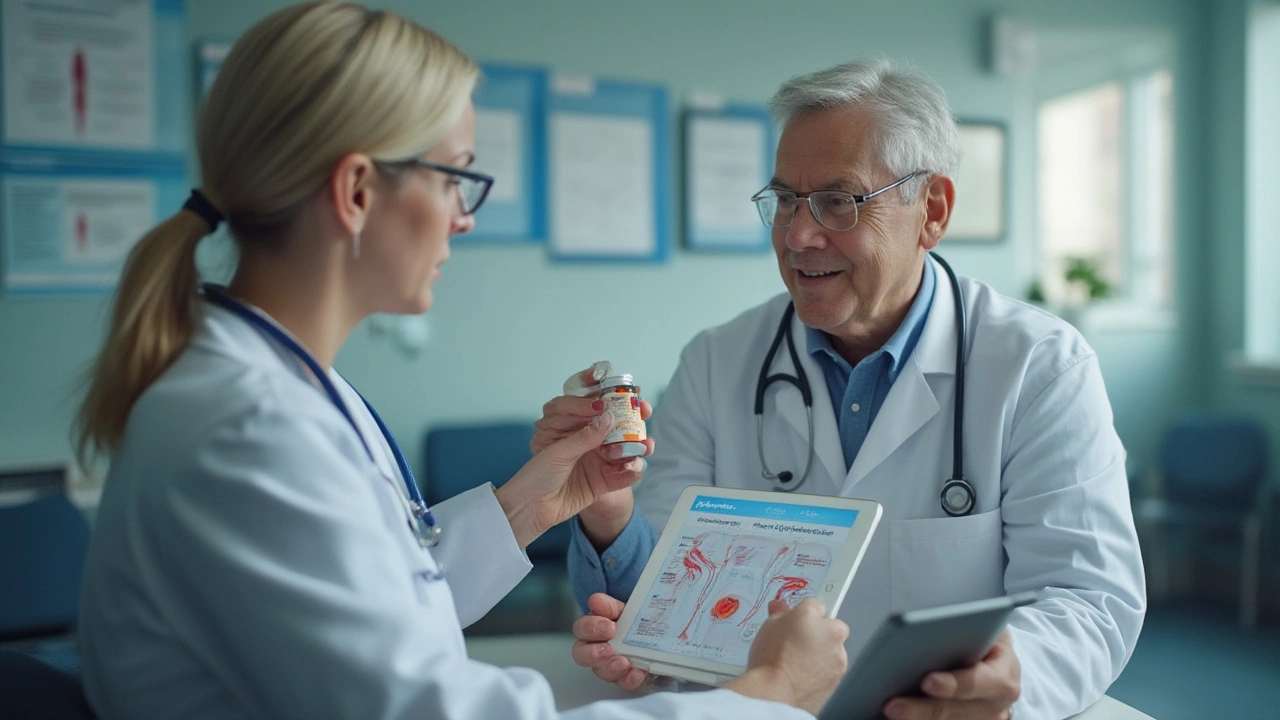Chronic kidney disease (CKD) can turn eating a simple meal into a chemical balancing act. One out-of-place mineral and suddenly, you’re deep in trouble. Here’s the twist: most people have never heard of phosphorus being a villain, but when your kidneys start to pack it in, too much phosphorus can spell real trouble. We’re not talking minor issues here—too much phosphorus makes bones brittle, skin itch like crazy, and it messes badly with your heart. Most CKD patients don’t even realize their food is packed with this stuff. Renagel steps in as a trusty guard, tackling this sneaky threat every meal.
How Renagel Works and Why It Matters
Renagel—also known as sevelamer hydrochloride—was a game-changer when it landed in pharmacies. It doesn’t let phosphorus get absorbed into your blood. Instead, think of it as a sponge. You swallow the tablet with meals, it passes through your gut, grabs hold of the phosphorus from your food, and together, they exit out the other end. The science is simple, but the effects? Life-changing. Renagel isn’t like calcium-based binders that boost your calcium level—which itself can lead to gritty, dangerous deposits in your arteries. Nope, Renagel pulls phosphorus with less risk of clogging up blood vessels.
Why do CKD patients need this? When your kidneys work, they keep phosphorus balanced. But as kidney function drops (especially at Stage 4 or Stage 5 CKD), phosphorus builds up in your system fast. High phosphorus is sneaky. At first, it’s just a number in your lab work. But over months and years, bones start to weaken, risking breaks from the smallest trip. Too much phosphorus also messes with how blood vessels work. One study out of the Journal of the American Society of Nephrology said heart disease risk in CKD patients soars as phosphorus climbs. And let’s be real—nobody needs extra heart risk when they’re fighting kidney failure.
Here’s a stat for you: About 80% of Americans with end-stage renal disease (ESRD) develop high phosphorus. Lots get put on Renagel or its cousin, Renvela (which is sevelamer carbonate). But physicians say sticking with the right dose is just as important as the prescription itself. Renagel only works if you take it exactly as told, and always with meals. Miss your pill, or take it an hour after dinner, and you’re letting phosphorus sneak right past.
Some kidney docs share stories of patients who felt more energetic and had fewer bone aches after just a few weeks on Renagel. There’s no magic, but when phosphorus levels drop to target, your whole body feels the difference. Some folks even report their skin itching less—a huge relief, since CKD itch can keep you up all night.
One sneaky part about Renagel is that it doesn’t work on an empty stomach—there’s nothing for it to bind with except air. That’s why docs stress: "Take with meals, every time." Mess that up and the numbers won’t budge.
If you’re a numbers person, check out this simplified stat table below:
| Kidney Stage | Recommended Blood Phosphorus (mg/dL) | Chance of Needing Renagel |
|---|---|---|
| Stage 1-2 | 2.5 - 4.5 | Rare |
| Stage 3 | 2.5 - 4.5 | Uncommon |
| Stage 4 | 2.5 - 4.5 | Frequent |
| Stage 5 (ESRD) | 3.5 - 5.5 | Very Common |
Remember, *Renagel* is the name you’re likely to hear in North America, especially the US. If you get confused by "sevelamer," know it’s the same ingredient.

Taking Renagel: Tips, Dosage, and What to Expect
Most folks get Renagel in tablet form. Typical starting dose for adults is 800 to 1600 mg per meal (so, 2-3 times a day). Doc might bump up the dose or drop it down depending on how your bloodwork looks. Each person is a little different—some absorb more phosphorus from food, some less, so regular lab tests usually steer exactly how much Renagel you need. That means you’ll hear a lot about your serum phosphorus number at checkups.
Here's the kicker: if you forget a dose, don’t double up at the next meal. Just skip and get back on track. Trying to "catch up" can leave you with a stomach ache, or worse. And while Renagel doesn’t mix much into the bloodstream (meaning fewer side effects than other phosphate binders), it’s not a pill you want to pop at random.
Some practical tips from folks who’ve used it:
- Keep your pill bottle on the dining table or in your lunch bag—somewhere you’ll see it at mealtimes.
- Take with the *first bite* of your meal, not as an afterthought. More food in the stomach means more phosphorus to grab.
- If you use supplements, tell your doctor. Renagel can block absorption of other important stuff, like certain vitamins.
- Drink plenty of fluids, unless your doctor tells you otherwise.
- If the pills are too big, ask about the powder form—you can mix it with water.
Diet plays a major role, too. Renagel isn’t an excuse to eat all the cheese pizza and processed food you want. The fewer phosphorus-rich foods you eat, the easier it is for Renagel to keep up. High-phosphorus foods include dairy, organ meats, nuts, beans, and most sodas (especially dark colas). In some cases, folks have counted up to 1000 mg or more of phosphorus in just a regular day’s diet—way too much when you’re dealing with CKD or on dialysis.
Maybe you’re wondering: Can you crush Renagel tablets? Most docs advise against it. The coating helps it work the way it’s supposed to. If swallowing pills is hard, talk to your team about alternatives.
Timing your Renagel really does matter. There was a study in Nephrology Dialysis Transplantation showing big differences in phosphorus levels between folks who took their binder *with* meals versus after. Taking with meals wins, every time.
The big win with Renagel, though, is that it usually doesn’t drive up calcium like traditional binders. People used to worry about calcification—where calcium piles up in heart valves and arteries. With Renagel, those issues are often lower. No drug is perfect, but this is a key selling point your doc might mention.
And don’t skip lab appointments. Your annual or even quarterly phosphorus checks aren’t just busywork—they tell your doc whether your current dose is working or needs a tweak.

Potential Side Effects, Safety, and Long-Term Experience
No pill is totally side-effect free. The most common complaints with Renagel are gut-related: belly pain, gas, bloating, or even mild constipation. A minority of users say the medicine makes them feel queasy—usually, that eases after a couple of weeks. If the symptoms hang around, sometimes switching to Renvela (a slightly different version) does the trick.
Rarely, some people notice more serious stuff like trouble swallowing or severe blockages. It’s uncommon but possible. If you have ever had major stomach surgery or long-standing digestive problems, make sure your kidney team knows—sometimes Renagel isn't the right fit in those situations.
One overlooked fact is that Renagel, by binding up phosphorus, can also grab some vitamins or other minerals by accident. Your doc might check your levels of vitamins D, K, and folate every so often. You may need supplements adjusted over time. In the long run, you want to avoid both low phosphorus (which weakens bones) and very high phosphorus (which hardens arteries and soft tissues).
For people who juggle a full tray of pills—blood pressure meds, EPO shots, and more—Renagel sometimes feels like "one more tablet." But when you look at the research, patients who stuck with their binder had better outcomes. A major clinical study called DOPPS (Dialysis Outcomes and Practice Patterns) found folks with controlled phosphorus—whether from Renagel or diet—lived longer, with lower risk of needing hospital stays for heart or bone issues.
Here’s a quick tip: don’t start or stop Renagel on your own. It might not seem like a hardcore drug, but sudden changes can make labs go haywire. Many kidney teams recommend a "medication review" every six months to see how each drug fits your changing body.
Worried about the price? It’s true—Renagel isn’t cheap, especially without good insurance. Generic sevelamer is sometimes available. If you’re struggling with cost, let your care team know. There are patient assistance programs, and sometimes small tweaks in dose can stretch out supply without sacrificing control.
Some folks ask about taking Renagel with antacids or other prescription heartburn meds. Most doctors give the green light, but always double-check. And while over-the-counter vitamins seem harmless, ask first—some binders can block absorption, making your pricey supplements less effective.
Finally, don’t be shy about asking questions or asking for a pharmacy consult. Your pharmacist is a goldmine for pill-taking hacks (like how to remember doses or what to do if a side effect bugs you).
Renagel isn’t famous outside the kidney world, but for thousands of people eating carefully, checking food labels, and fighting to stay healthy, it plays a huge role. Managing phosphorus isn’t glamorous, but when you get it right, you can feel the difference from head to toe. Everyone’s journey with kidney disease is different—but if your care team brings up Renagel, now you know why it’s a staple, and how you can make the most out of every pill.

12 Comments
Krishna Garimella July 10 2025
Renagel is truly a fascinating medication with a key role in managing chronic kidney disease. High phosphorus can cause so many complications, so it’s critical we understand how to balance that level.
I appreciate posts like this that break down the uses, dosage, and side effects clearly. It makes the whole topic less daunting for patients and caregivers.
One thing I wonder though, is there a recommended diet to go alongside Renagel usage that can further help control phosphorus? It seems like a holistic approach often works best with such chronic conditions.
Also, I’m curious about what makes Renagel preferable over other phosphate binders on the market? Is it more effective or better tolerated?
abigail loterina July 10 2025
This post does a wonderful job highlighting the importance of Renagel! It’s crucial for people with chronic kidney disease to be aware of how medications like this assist in managing dangerous phosphorus levels safely.
I also think it’s helpful to remind everyone to always follow their doctor’s instructions about dosage exactly and report any side effects promptly.
One tip from my experience: breaking the medicine into smaller doses throughout the day can really help with tolerance and effectiveness. Has anyone else tried this approach?
Virat Mishra July 10 2025
Ugh, medications like Renagel always seem like a hassle with all the side effects and strict schedules. I get why it’s important, but sometimes I wonder if the cure is almost as bad as the disease.
Has anyone experienced serious downsides from this drug? I mean, if it causes more trouble, is it still worth taking?
Maybe lifestyle and diet changes could do more good without all the fuss of pharmaceuticals. Just throwing it out there.
Daisy Aguirre July 10 2025
I totally get your frustration, but honestly, Renagel has transformed quality of life for a lot of people I know! 🌟 It’s about balancing risks and benefits. Yes, side effects exist, but the potential to prevent serious complications from high phosphorus is huge.
Also, supportive care and education around its use empower patients to feel more in control. This kind of medication combined with a well-managed diet is a powerful combo. 🌈
Embracing this with positivity can make a world of difference when dealing with chronic kidney disease.
Roger Cole July 10 2025
Important topic indeed. But let’s not forget that every medication, including Renagel, should be carefully monitored by healthcare providers to ensure safety and effectiveness.
It’s essential to adhere strictly to prescribed dosages and report any unusual symptoms immediately. Phosphorus control is critical, but so is patient safety.
nalina Rajkumar July 10 2025
Love seeing info like this shared here 😄👌 High phosphorus is scaryyyy but this medicine sounds like a real help! Gotta remember to take it with meals tho 😉👌
Hope people also keep hydrated and eat easy on salt and processed food, that 💯 helps too!
Gavin Potenza July 10 2025
Reflecting on the role of Renagel invites a broader philosophical question about the interplay between medication and lifestyle. While Renagel addresses the biochemical imbalance, it also reminds us of the deep responsibility we hold towards our bodies through diet and self-care.
Medicine is a tool, certainly, but not the only answer. Awareness and patient education are what truly empower long-term wellness.
Natalie Kelly July 10 2025
thanks for the info! ive seen renagel recommended a lot for phosphorous issues in kidney pts but never really got why it was so important. now it makes sense. i wonder if all kidney patients get prescribed this or just some?
also, can anyone confirm if it’s hard to take daily? some medicines are tough for ppl to keep up with
Sandy Gold July 10 2025
Honestly, I think the emphasis on Renagel is a bit overblown. Sure, it lowers phosphate, but there are other binders that work just as well with fewer side effects.
Plus, the 'low phosphorus' diet advice is often oversimplified and ignores individual patient needs. I wouldn’t just take this at face value without deeper clinical evaluation and personalization.
Also, the side effects section in posts like this often glosses over important details.
abigail loterina July 10 2025
I understand the concerns about side effects and one-size-fits-all advice, but this post carefully encourages consulting healthcare professionals. That’s key!
Medications like Renagel are prescribed based on individual assessments. The article’s clarity can help patients ask informed questions during their visits.
Daisy Aguirre July 10 2025
Yes exactly, personalizing treatment is everything. Also worth remembering that all medicines have pros and cons; the focus should be on how they improve overall outcomes instead of just potential negatives.
Thanks for bringing up critical thinking on this topic!
Inma Sims July 10 2025
Oh, fantastic 🙄 another miracle drug savior post. Look, yes, Renagel has its place but can we stop pretending it’s some cure-all without real drawbacks?
Side effects aren’t just 'possible'—they’re often significant, and no mention here on pill burden or cost implications for patients. Why sugarcoat everything?
Just my highly formal two cents.